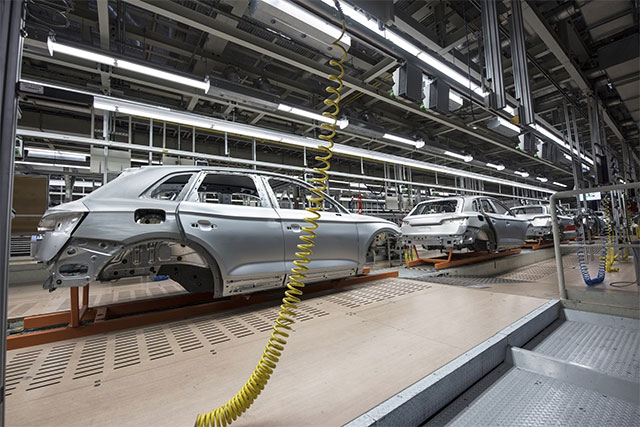Cars and vans were the most significant source of transportation emissions in 2022, accounting for 48% of global transportation emissions!
The automotive sector, hence, has been racing to meet net-zero goals.
While EVs (Electric Vehicles) continue to steal the spotlight from petrol and diesel cars, each stage of automobile production will benefit more from safe, sustainable and efficient solutions. Recycling EV batteries and using recyclable manufacturing components are a few solutions. However, automobile manufacturers long for more ways to create an even more sustainable model.
Through this blog, we’ll go through five such ways. From leveraging tech to implementing sustainable design practices, the blog covers sustainable approaches practical for all pre and post-stages of manufacturing to production.
Let’s get to it right away!
Table of Contents
1. Use preventive maintenance schedule template for fleets
Simply following the manufacturer’s maintenance schedule helps reduce pollution from vehicles and engines. Easy? Well, not as much.
Getting timely services may seem easy, but it requires effort. The effort multiplies when you manage a fleet. How do you ensure all your vehicles undergo timely servicing? Sure, you could track vehicles using paper forms or spreadsheets. But sadly, we’re not in the 80s anymore.
Here’s when template scheduling fleet preventative maintenance comes in handy. With preventative maintenance templates, you can access even the historical data of each fleet vehicle and set alerts for future maintenance needs. Using such templates also benefits you with the following:
- Identify potential issues early on: Maintenance schedules ensure all vehicles undergo regular servicing and identify potential issues before they escalate.
- Enhance overall fleet reliability: By addressing wear and tear timely, you prevent sudden breakdowns in vehicles during operations, increasing their lifespan on the road and improving overall fleet reliability.
- Higher ROI: Well-maintained vehicles undoubtedly operate better and for longer durations, eventually giving you a high ROI (Return on Investment)
This solution, especially if your business falls under fleet management or transportation, saves you ample time and costs in the long run. However, using maintenance schedule templates is one way to keep the fleet’s health in check. Leverage battery analytics software if you want to narrow it down further.
2. Leverage battery analytics software
Replacing batteries depending on pre-defined contractual agreements is still one of the best practices to retain the vehicle’s health. However, there are better alternatives to this–battery analytics being one.
As fleet managers continue to leverage tech to optimize the vehicle’s overall performance, they also heavily rely on battery analytics to optimize their operations. For example, a manager using the Elysia battery analytics software that monitors and analyzes the performance of the batteries in the vehicles is more likely to maintain the overall health of the fleet than the ones without it.
The software monitors,
- charge, discharge rates,
- temperatures,
- battery capacity.
These cumulatively aid in improving the battery’s efficiency. Moreover, it also helps with the following:
- Reduced operational costs: Drastic changes in battery performance require immediate repairs, which could cost you a hefty amount. With battery analytics, you could identify such potential threats early on, thus reducing operational costs.
- Reduces asymmetric data: While batteries have been a core part of an automobile, it’s still a technical asset, especially in the car industry. Reliable analytics software makes them more accessible and economical and opens new economic pathways.
- It helps owners decide whether to resell, reuse or recycle: Since the software gauges the battery’s capacity, it allows owners to choose whether to resell, reuse or recycle the battery, ensuring timely disposal of batteries.
3. Implement sustainable design practices
The primary step in automobile production is designing. If owners start using recyclable materials in the initial manufacturing stages, it will automatically incorporate sustainability into the manufacturing process.
The underlying question is how to implement such practices and meet the demands of environmentally conscious consumers. Here are several ways to incorporate sustainability into car manufacturing processes:
- Choose bio-based recyclable manufacturing materials: Reduce the reliance on virgin resources and opt for lightweight, biodegradable materials such as carbon fiber, aluminum and other composites to enhance fuel efficiency and reduce emissions. Explore natural fibers and reduce the usage of synthetic ones.
- Recycle waste: Manufacturing units produce tons of waste. Enforce recycling programs within the unit as recycling scrap materials prevents natural resources and conserves energy.
- Conduct LCAs (Lifecycle Assessments) throughout the product life cycle: LCAs analyze the environmental impact of products throughout their production, aiding in making design decisions. Increase the focus on using eco-design principles that focus on recyclability.
- Implement closed-loop systems: Design processes with closed-room systems generate negligible wastage as the waste from one process becomes raw material for the other. So implementing such systems along with recycling programs is essential to Also enforce recycling programs to recycle plastic, paper and metal within the manufacturing unit.
4. Utilize Energy Management Systems (EMS)
You need solutions that aren’t solely sustainable but also safe and efficient. Energy management systems perfectly fulfill all three parameters. These systems also help you achieve substantial cost savings in the long run.
Optimizing energy reduces greenhouse gas emissions while supporting efforts to mitigate climate change.
By optimizing energy usage and embracing technological innovation, we can drive transformation toward a sustainable future. Let’s get into the specifics of why energy management systems might be for you.
- Monitor energy usage: One of the most significant advantages of using an EMS is it monitors energy usage in manufacturing processes. So, if your manufacturing equipment has a sensor or meter attached to it and signals high-energy consumption, consider replacing it.
- Opens a node for renewable energy integration: Since EMS tracks energy consumption patterns, it automatically leaves scope for an alternative, such as using solar power or wind in manufacturing. You could align production process schedules with the availability of renewable energy sources, minimizing reliance on conventional power sources.
- Early detection of equipment malfunctions: Detecting malfunctions early on is one of the basics of maintaining industrial vehicles. By integrating an EMS, you could identify a potential equipment malfunction early and save money!
- It saves you from hefty fines: EMS is a holistic approach toward attaining sustainability and efficiency and complying with energy-related regulations. They ensure compliance and void fines and potential legal issues, fostering a positive image in the market.
Integrate EMS into your employee management tools or programs to raise awareness about using energy-saving practices—reward employees who take energy conservation initiatives and promote a sustainability culture. This brings us to our next point.
5. Conduct employee training programs and workshops
Given the numerous concurrent processes and units involved, attaining efficiency and sustainability in the automotive sector is a group effort.
With emerging tech trends, you must figure out ways to keep your employees in sync. Training workshops do that. From learning new ways to make your business more sustainable to implementing the practices in real time, training programs at regular intervals ensure an ongoing learning process that benefits you and the business.
The training programs educate employees about sustainable practices and create awareness about the significance of efficiency and environmental conservation. You could conduct training programs on the following topics:
- Environmental impact of existing workflows: Only some employees know the impact work processes may have on the environment. And if they don’t know, how do they practice eco-friendly practices? Such workshops inform employees about the impact of existing work processes on the environment so they know better and do better.
- Energy saving techniques: Actions such as turning off the computers or switching off lights when no one’s in the room can save energy. Have expert sessions on other creative ways to save energy.
- Safety and emergency response: Organize training sessions on safety protocols to avoid environmental hazards and steps to respond effectively when they do. This includes handling hazardous materials and disposing harmful materials used in manufacturing.
- The future of Automotive sector is in your hands: Being environmentally conscious is the way to be consumer-centric. So it’s not about hopping on the sustainability bandwagon; it’s about making a conscious choice toward protecting the environment as a manufacturer.
The ways to leverage sustainability into your manufacturing process vary based on where your company currently stands from a sustainability standpoint. For instance, you may already use reusable manufacturing components in your units but still need to dip your toe into optimizing batteries or vice versa. Identify such gaps and fill those with suitable practice/s mentioned in this article.
Also, tech innovation and the automotive industry go hand in hand. So, keep an eye on the latest tech trends and incorporate them into your existing systems!















